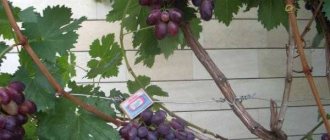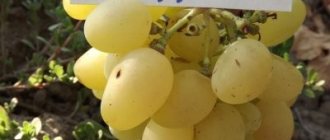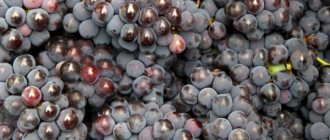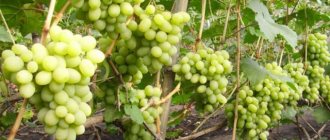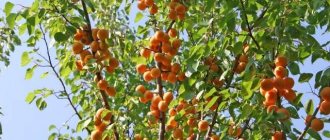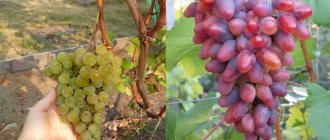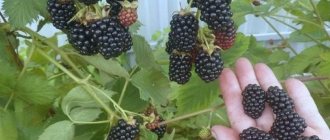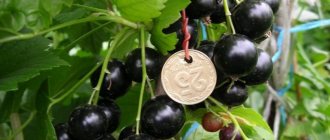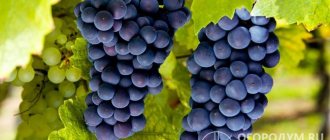History of variety selection
The authorship of the variety belongs to Novocherkassk VNIIViV named after. ME AND. Potapenko. The selection material was vines of two varieties: the Hungarian “Zala Dendy” and “Magarach’s Gift”, selected by the Yalta VNIIViV “Magarach”.
An application for registration of a newly bred early grape variety called Platovsky was submitted by employees of the Novocherkassk All-Russian Research Institute of Viticulture named after. ME AND. Potapenko was submitted in 2002. In 2003, the variety was officially registered in the State Register of Breeding Achievements. The second name that can be found among manufacturers of planting material is “Early Dawn”.
Description of Platovsky grapes
Technical grapes for their primary purpose ripen in just 110-115 days. The growth of vines per year is average. The clusters on the bush are small in size, on average 200 g each. Their shape is mostly cylindrical-conical. A photo of Platovsky grapes shows that the clusters are not too large, like many other technical varieties.
Grapes are initially light green or even whitish in color. During the season they gain weight up to 2 g. The shape is round, with a thin, but strong and fairly tough skin. As they ripen, they acquire a slight pinkish tint. The taste is rated as pleasant, sweet and sour. The dry table wine obtained from Platov grapes has a tasting score of 8.4 points.
Juice pressed from fresh ripe Platovsky grapes contains up to 8.9 g of acid per 1 liter, sugar content is 20.2%. Of all the growing shoots, 85% are fruitful. On average, 1-2 clusters are formed on one shoot. After ripening, there is about a month to harvest the Platovsky grape bushes, during which the clusters remain dense and the berries do not fall off. The variety is zoned for the Crimea and the North Caucasus.
Forum statistics
207034 Messages in 1634 Topics from 5593 Users. Latest user: Amaya Latest message: “Ripening dates are different...” ( Today at 07:25:15 ) Latest messages on the forum.
Now on the forum
25 Guests, 3 Users
Users in the last 15 minutes: Marshal, Cherkessk, Elvira2017 [Blocked] [Section Moderator] [Forum Moderator]
Maximum online today: 77 . All-time maximum online: 2758 (28 July 2021, 17:22:51)
Users who visited the forum in the last 24 hours
Total: 298
(Visible: 297, Hidden: 1) 1963, Cherkessk, Elvira2017, Marshal, Eugene, zsb, leonidych, vladimirM, yotmast, mers, Serg1707, SNovichek, hanter64, znakomij, Alexander K, Vardan, Sergey Fer, Anatoly Sivkov, Alexey V , Ilya 77, Andrey Gladilin, Tatyana A., Belgorodets, in Astrakhan, Oksana Kopp, Tatyana B, sem_en, Alex65, Vladimir 153, skier, Igor Viktorovich, slavalimon, Alexander Vl., Primorets, OlgaOs, SANYCH, 31rus, mystic69, DorontsovPeter, Andrey Tsvetkov, Buba, igor222, Andrey76, Elena Z, vlad51, Kenig, Nikolay Rex, Sergey 1965, Vladimir Buturlakin, DSW, psv1960, Dmitry 77, Vasily V., Vyacheslav03, Natalia Nikolaevna, Sergey Tashchiyan, Nikolay S., Igor Sergeevich, alexsandr, kvg, Pioneer, Polyanina Ekaterina, nicson7, Elena Aleshchenko, Alexander-ask-34, Verona, Igor F., Taker, Tikhii, Henry, Yuri72, L.A.P., Gaivoronsky Yuri, Sergeevich, Sergey Purekhokletov, Svetlana Streletskaya, Galinka, Aleksey Deminov, Naumov Igor, Vyacheslav136, gloomy, Katrin, Andsanych, Mikhno Alexander, Grandfather31, Filippov Oleg, Vladimir ++, Svetla777, Mikhail Alekseevich, Lidia58, Mikhail77, Alexander Bryansky, VLADIMIR-KANEVSKAYA, DIL , Amber7394, Marina Protasova, TITOVA LYUBOV, Linx, alexander66, Natalya M, Mikhail Fesenko, ElenkaF, Amaya, Alexander71, Boris 1952, tsv, Maximilian, 25nata35, nadia, GALINA ANOKHINA, Igor_K, Alexander Kolesnikov, Ivan Levin, Pitko, weather forecaster , eSAa, cecet71, atseton, Alexander Smirnov, Vladimir Kostochkin, Vladimir Berdnikov, Gocha, pioneer-2, LeXa_KoT, Sergey 61, Sergey Yuryev, Erem, alexss, Evgeniy52, Skif, lomakin1969, Vladimir Kovba, dayton, Yuri Semyonov, N. A. Sokolov, Pavlentiy, Sa-shura, Volgogradka, Dmitry Anatolyevich, Grandfather Igor, Andrey Lis, Bublichenko Alexander M, Marina Krymskaya, stenlly2010, irahelm, Vyacheslav Vladimirovich, Vladimir Shilov, Aprel, Dmitry Badaev, gheo55, Yura, y_fed, rambo , Yagodka, Valentina Ivanovna, Kryn, oleg9f, DED2, Svetlana Korotina, Oleg Ivanovich delivered, Eduard., santra, L2k2m7n, Alexander48, Viknik, Andrey 31, m2d, Valery Rastorguev, Soshnin Yura, Amateur gardener, Galina, Vasily1111, gardener , marlin64, Salex, sergei, Sergey Ko, Ramiz, victor_, kosmos, potap05, Yuri 36, VitalySD, Inna161, Vova Kapran, Vladimir Shcherbinin, Valerie, niy1, cfibr, Andrey68, kulol3, Slavka, thanatos, Serzh1978, Realist, Artur53 , max2008-01, LOZA, AlexanderD, Grandfather Young, Natasha, Zayac, ketch, Rita, alx-74, Iv Iv, Alexander150, Igor K, Vasily Viktorovich, VeraNiK, kdm57, Veniaminovich, Boris Sokolyansky, therapist, Capricorn, 77volt, , vikbublik, neposny, Evgen, Victoria Aleksandrovna, Serezha 64, Wintel, Airbone, teri, Sergey Lomonosov, Khramov, serginio, Leonty Yarygin, Irina O., Ser, Nadezhda Grig, Lyubov S., netolya, Saisan, Alexey Agryzkov, Vadi , Zinaida, Vadim, Alexander Taganrog, Sukhononov Sergey, Snezhinets, Evgen_26, NAU_63, Masha_Sadovod, Gennady163, Krasnovlad1, Alexander Zinoviev, Vasily 53, Roman Fedorovich, Tis, Aleksey Sergeevich, Arnya, Zheka, Nurtas, Kradievska, 64nikolay64, Nick04, NickK 41, Liza , Valentina Medvedeva, Sergey43, Andrey S., Nikolay Lipunov, Mst, Vertuoz2, Vladimir VS, NatalyaMed, freesia, Kinna, Mikhail Michurinsk, alekcsan1, VALERY TAMB, Sasha57, MikhAf, Y_Azer, Andrey Beribesov, hunter1955, nut lover, Keys, Ivan Shmelev, Pestik, anton_slash, Nadymchanka, Sergey 31, Volgar, Pavel 64, Tatyana Volzh, Elektronik_t, Alexander 61, spotlight, Alexander Gai, Cheprak, Pirko Alexander, vladimirvrn, Antrikan, asun16, Alexey Viktorovich
Characteristics of the variety
In zoning areas, Platovsky is grown for further processing. But in private farms it is grown not only for wine and juice, but also for food. What gardeners especially appreciated is that the first harvest from a bush can be harvested already in the second year after planting the seedlings.
The description of the Platovsky grape variety indicates that in the first year after planting the vine grows quickly, without losing its growth rate in subsequent years. The flowering of the variety is bisexual. This is important to consider when planning planting grapes on the site. Platovsky is a pollinator for vines of other varieties.
Drought resistance, frost resistance
According to the description of the variety, it is able to withstand temperatures down to -29 °C in winter. In those regions for which it is zoned, the vine is used for landscaping terraces and gazebos, without being removed for shelter for the winter. If you plant the variety in a region where winters have little snow but are cold, then the bushes will need shelter.
In the autumn, when the Platovsky grapes shed their leaves, pruning is carried out. Then the bole is hilled and metal arcs are installed along which the agrofibre is stretched. To prevent the bushes from rotting, the entrance and exit to the “tunnels” are left open, closing at frosts below - 15 ° C. When snow falls, it is shoveled over the agrofibre.
Productivity and fruiting
On average, it takes 110 days for the brushes to mature, but much depends on weather conditions. The more sunny days there were during the season, the higher the quality of the harvest. If the berries have not had time to gain sweetness, they are left to ripen on the branches. They can continue to collect sugar for another month without falling off the bushes.
According to reviews, gardeners in the Moscow region harvest an average of up to 6 kg of berries per bush from Platovsky grapes. Their taste is pleasant, and their thick skin is not damaged during transportation. The yield is affected by the weather during flowering, since the presence of pollinators is important, as well as additional mineral fertilizing. In cloudy weather, keeping ripened berries on the bushes for a long time will not help; they will still remain sour.
Area of application of fruits
Thick brushes are great for storage and transportation. Since the taste of Platovsky grapes is assessed as very pleasant, its berries can often be found on sale next to table varieties in growing areas and beyond.
And yet the main purpose is technical. Most of the berry harvest is sent for processing to wine and vodka factories, where it is used to produce dry white and semi-sweet wine. The juice is suitable for canning; it is also pressed for subsequent sale in various containers.
Resistance to diseases and pests
According to the assessment of breeders who were testing a new variety at VNIIViV named after. ME AND. Potapenko, the resistance of Platovsky grapes to the following diseases is assessed:
- Mildew – 2 points;
- Oidium – 2.5 points;
- Phylloxera – 3 points;
- Gray rot – 2 points;
- Downy mildew – 2 points.
This means that even with severe damage to the leaves by diseases and insect pests, the Platovsky grape bush is capable of producing a harvest of berries. At the same time, the vine gratefully responds to preventive measures and timely treatment against diseases common in the area.
Advantages and disadvantages of the variety
Among the most important advantages of the Platovsky variety, the following were noted:
- Unpretentiousness to soil composition, rooting of seedlings on fertile and poor soils tends to 100%.
- It propagates easily, and it is recommended to use the “Cober 5BB” variety as a rootstock.
- Even after a short sanitary pruning, the bush produces a good harvest of berries next year.
- Under unfavorable weather conditions, slightly fewer berries are set than in sunny weather, but the amount of sugar in them will be reduced.
- Harvest time: 1 month after ripening.
- Platovsky grape berries can be consumed fresh, processed into wine and juice, and also dried.
- Due to the high sugar content, it is possible to obtain wine of excellent quality and strength.
Among the disadvantages of the variety, the need for shelter in regions where winters are cold and with little snow is noted.
Reviews
- Alexander, Kaluga: “The grapes don’t look great. The berries are small, ordinary, the clusters are small, but from my point of view, they have excellent taste. In addition, “Platovsky” produces a large harvest.”
- Ekaterina, Rostov-on-Don : “Platovsky” is an option for those summer residents who come only on Saturday and Sunday. There is no need to water, there is no need to prune endlessly, there is no need to fight diseases. And the grapes, although not large, are tasty.”
- Stanislav, Belogorye: “I grow “Platovsky” and “Crystal” on the “Lydia” rootstock. I replaced them with varieties to get edible grapes that can survive frost. Very satisfied. The berry is not large, but for a technical variety this is not a drawback.”
- Boris, Kazan: “An excellent frost-resistant variety. Even in the worst summer, sugar levels rise. But, it’s true, not every grape survives in our conditions. I want to find a black one with the same characteristics as Platovsky.
“Platovsky” is settling in very well in its new location. Under favorable circumstances and good care, the first brushes appear the very next year after planting. However, the vineyard reaches full fruitfulness after 3 years.
The berries begin to actively ripen by early August. The clusters can remain on the bush for a long time: at the end of September, the shape and juiciness of the grapes remains the same as in mid-August.
The Platovsky variety is one of the most successful options for white wine grapes. However, its excellent taste made it popular not only among winemakers, but also among ordinary summer residents.
How to plant Platovsky grapes
Since the Platovsky variety is a technical variety, it is used for cultivation in private vineyards, as well as in industrial ones, where the care and collection of berries is carried out using mechanization. The variety responds gratefully to care, producing a stable harvest.
Recommended timing
Platovsky grape variety can be planted in both spring and autumn. Autumn planting is most often used. The first ten days of October are ideal. Even 10 days before a stable cold snap is enough for seedlings to take root in a new place. If the cold weather lingers, then by winter the bushes will have time to grow enough roots to survive the upcoming frosts. In spring, young bushes are planted when the soil warms up above + 12 °C.
Choosing a suitable location
Since all grape varieties, including Platovsky, are light-loving, areas for planting bushes are chosen so that the light falls on the rows from the south, west or southwest. It is not recommended to plant close to fences or building walls, as this significantly impairs the lighting of bushes that are not too tall. A distance of at least 5 m should be maintained from nearby fruit trees.
Low-lying areas, where moisture easily accumulates after rains, as well as in the spring after snow melts, are not suitable for grapes. Despite all its moisture-loving nature, Platovsky does not tolerate stagnation of water at the roots. If the plot is located on a slope, then it is best to allocate its middle part for the vineyard.
Selection and preparation of planting material
Most of the planting material of this variety is annual seedlings, the height of which is approximately 50 cm. A high-quality seedling has a thickness of about 1.5 cm. The roots are about 10 cm long. Sellers usually display Platovsky grapes in containers with a damp mash of earth and clay, so that the roots do not dry out. You should pay attention to the condition of your kidneys. They should be strong and barely burst in the spring. Nothing will grow from a seedling with dry or broken buds.
Landing algorithm
2-3 weeks before the expected planting date of the Platovsky variety, they begin to prepare planting holes or trenches. They do this in the following sequence:
- Mark places for holes. The gap between individual bushes is 80 cm, the depth of holes and trenches is 60 cm.
- A layer of small crushed stone or pebbles or expanded clay 10 cm thick is poured onto the bottom.
- Supports are installed in the center of the holes or trenches, to which seedlings are tied after backfilling. Tops of 15-20 cm in height should remain above the ground.
- For each hole or under each seedling, add a bucket of compost, to which add a glass of nitrophoska and wood ash.
Planting of Platovsky grapes is carried out in accordance with the accepted markings. The seedlings are lowered into the holes, carefully straightening the roots. Backfilling is carried out so that the eyes are above the ground (3-4 buds). Watering is carried out immediately so that the soil in the hole settles as densely as possible, and more is added if necessary.
When planting in autumn, in order to speed up the process of establishment of seedlings of the Platovsky variety, the ground under them is covered with film. Due to this, the soil around the bushes does not dry out too quickly.
How to grow
"Platovsky" is very undemanding in care. The grapes produce small berries, the clusters are not large, so such an acute dependence on the overload of the bush, as happens in the corresponding varieties, is not observed here. The most important requirement remains excellent lighting.
- Watering - in fact, grapes only need abundant watering in the first 2 weeks. Then watering is carried out based on soil moisture and aridity of the region. The second important stage of watering is before covering the bushes for the winter. Before and during flowering, the plant does not need special watering. It will also be useful to learn about what to feed the grapes during flowering, and how to do it correctly.
- Trimming – on average there can be 50–60 eyes on a bush. 3-4 eyes are left on the main vine. All unnecessary buds and shoots are broken off to ensure sufficient sugar accumulation. For the same purpose, remove the leaves near the brush.
Grape pruning - Mulching - a great way to retain moisture for a long time in a dry area. Mulch is poured 2 weeks after planting, and subsequently loosened.
Mulching grapes
- Processing – the variety is resistant to many diseases and pests, but not all. Treatment with fungicides is carried out according to the usual scheme and allows you to protect the plant from anthracosis, black spot, and so on.
But how to properly plant a grape seedling, and what you should pay attention to, is described in great detail in the contents of the article at the link.
Another important pest is wasps. There are no chemical means of controlling insects, so you have to do it the old fashioned way: place an equally sweet product - honey, a slice of watermelon - next to the ripening bunches.
The bush does not need special protection in winter, but if frosts in the region can be lower - -30 C, it is advisable to cover the bushes with spruce or straw.
Aftercare for grapes
The process of caring for Platovsky grapes does not differ significantly from the standard one required by most technical varieties. Fertilizing and watering, especially in the first years, can significantly increase productivity. To avoid mass damage by diseases and insects, preventive treatments with insecticides and fungicides are carried out in the spring. In autumn it is necessary to prune.
During the first month after planting, seedlings of the Platovsky variety are watered daily, consumption is about 5 liters per bush. In the future, it is enough to water once every 2 weeks. If we are talking about adult bushes, then they will need abundant watering only a few times per season:
- In the spring, as soon as the coverings are removed from the bushes.
- A week before flowering.
- Immediately after flowering and berry formation.
The optimal water consumption when watering Platovsky grapes is 5 liters for each plant. Wood ash is added to the water. The rule works: it is better to water less often, but abundantly, than often, but a little at a time. Water is released along the ground, preventing it from getting on leaves, berries and stems. A drip irrigation system made from perforated pipes or hoses dug into the ground is ideal. In some cases, watering is carried out along grooves that are dug at a distance of 30 cm from the bushes to a depth of 25 cm.
When the berries begin to ripen, stop watering the Platovsky grapes, as it can cause them to crack. In the fall, 10 days before the first cold weather, the last moisture supply is carried out, which should help the grapes prepare for winter.
If all the necessary fertilizers have been added to the planting hole, then the next feeding of this variety will be required only in the 3rd year of life. Then the plants are considered mature and begin to actively bear fruit. The preferred scheme for applying fertilizing to Platovsky variety bushes:
- In early spring with buds opening. Slurry is added with the addition of superphosphate and potassium salt. Instead of manure, urea or ammonium nitrate is used.
- When forcing brushes. Potassium and phosphorus fertilizers are scattered over the soil or added to irrigation water.
- When the first berries begin to ripen. In cloudy weather, they are sprayed with complex preparations: “Novofert”, “Aquarin”, “Kemir”.
To facilitate the process of caring for Platovsky grape vines and to avoid breaking off under the weight of ripening clusters and berries, the shoots are tied to supports. Usually, at the beginning and end of the row, pipes are installed vertically (if the row is long, then intermediate supports are also installed), to which wire is tied. Only such a support will support the heavy vine of this variety, strewn with berries. You can direct the shoots horizontally, vertically and in an arc.
Trimming
One bush of the Platovsky grape variety is capable of providing normal growth for 80 eyes. To do this, the shoots of last year are cut off, leaving 3-4 eyes on them after the fork. Stepchildren must be removed during the summer after the last cluster so that the bush does not waste energy on them. If the clusters are too heavily covered with foliage, then they are cut through, allowing the berries access to the sun.
Pruning is carried out in the fall, when all the foliage has been dropped. Spring pruning of grapes is not recommended, since it causes the vine to release juices. Platovsky’s yield suffers from this, and the bush may even die. In spring, only dried and frozen branches of bushes are pruned.
Protecting crops from birds and insects
The threat to the future harvest of Platovsky grapes is posed by attacks from birds, as well as bees and wasps. To protect against them use:
- Insecticides. However, it is important to understand that the poison will not be completely removed and will remain partially in the grapes.
- Net. This method is the most environmentally friendly and has no restrictions.
To protect Platovsky berries, in private vineyards, when there are only a few vines, they use netting to wrap each cluster. But for large areas this method is too labor-intensive. It is much easier to install additional supports and cover the entire planting of this variety and others with a net. It does not interfere with the passage of sunlight and air to the berries and foliage, but does not allow insects and birds to pass through. The net is installed when the crop begins to ripen.
Preparing the crop for winter
Procedures for preparing Platovsky grapes for winter begin with the first frost. By this time, most of the foliage from the bush should have already been dropped, and the mature vines have acquired their natural brown color.
The first is pruning, and all unripe remaining green vines are cut out. Then the grapes are catarrhized, cutting off the roots in the cervical part of the trunk to a depth of 20 cm. This treatment will eliminate the risk of freezing of the upper (dew) roots, giving the rest of the root system the opportunity to use all resources for growth.
If shelter is required in a given region, then Platovsky grapes are removed from the trellises and lowered to the ground, metal arcs are installed along the row and agrofibre is stretched. Its ends are closed only in frosts below 15 °C. The shelter from Platovsky should be removed in the spring when the buds awaken.
It is recommended to hill up the standard. This will increase the winter hardiness of the bush. To prevent damage to vines by rodents, it is important to remove fallen leaves, which serve as excellent building material for mouse nests. To rid Platovsky grapes of mice, baits, traps, and hard shelters (for example, slate) are used.
Features of cultivation
The grapes are unpretentious. Basic steps to care for the bush will ensure a stable harvest.
- It is better to plant a vineyard on chernozem, loam or clay-calcareous soil; during planting, you must fill the holes with drainage if the groundwater is close to the surface.
- Another important point is the constant access of the sun to the crop.
- A good option is mulching the soil under the bushes.
- Regular fertilizing (2 - 3 times a year) with fertilizers containing potassium, phosphorus, nitrogen, or compost during the flowering period is the key to a bountiful harvest.
- At high temperatures, the crop needs abundant watering. You should not forget about it in the spring when the leaves are blooming and in the fall when preparing the bush for winter.
Trimming
The plant is pruned in the fall (September - October) after the first frost - excess shoots are removed, in the spring (April) - dry and frozen branches. In the summer you need to cut off useless stepsons.
For this variety, short pruning is recommended, as a result of which 3 to 4 eyes will remain on each branch. To allow sugar to accumulate in the berries, it is recommended to remove the leaves that cover the bunches. How to make trellises from plastic pipes and more in a separate article.
Resistance to diseases and pests
The Platovsky variety is characterized by high resistance to various diseases. Spraying should still be carried out for preventive purposes: twice a year, in spring and autumn, the bushes must be thoroughly treated with Bordeaux mixture (3%). Treating the trunk with iron sulfate will also give a good effect.
If, nevertheless, the plant “gets sick”, then it must be sprayed at the first signs of illness:
- For mildew and oidium - manganese solution (6 g per 10 l), iodine solution (3 g per 10 l).
- For gray rot - soda solution (75g per 10 liters of water).
The sweetness of the berries attracts wasps, bees and birds. Experienced winegrowers fight the former by treating the bushes with insecticides; however, it should be remembered that toxic substances are not completely removed from the fruits even after thorough washing. A more environmentally friendly way is to place sweet baits - honey or watermelon - next to the bushes. And the nets that wrap the brushes will help keep birds away.
Option for sheltering crops from sows and birds
Preparing for winter
The frost resistance of the variety allows you not to resort to covering the bushes for the winter: it can easily survive frosts of -28ºС, -30°С. This property of grapes allows it to be widely used in landscape design for landscaping arches, gazebos, and fences. But if the winter is expected to be harsh, then it is advisable to remove the lashes from the support, lay them on spruce branches and cover them with agrofibre or a laminate backing. It is better to cover the stem with earth. More details about covering grapes for the winter can be found in a separate article.
These recommendations will also be relevant for northern regions with long, cold winters.
Harvest storage
Ripe bunches can hang on the bush for a month without losing their presentation. “Platovsky” is well transported and retains its taste for a long time.
Regions
The variety is suitable for cultivation throughout Russia; in the middle zone (including the Moscow region) the clusters will ripen by the beginning of August. “Platovsky” is one of the frequently cultivated varieties in Ukraine, Moldova and Belarus.
Methods of propagation of grapes
Ripe branches are excellent for propagating Platovsky grapes, which are recommended to be minted with the final formation of the bunches. The part of the branch that is located above the brushes is not beneficial for the ripening of the crop and can be cut off. Barked shoots with a thickness of 1.5 cm or more are suitable.
Cut branches from the Platovsky variety bush into pieces 35-50 cm long with 4-5 buds are stuck into pots with soil or buried in a free area until autumn. If by the first ten days several new leaves have formed on the seedling, then it can be safely transplanted to a new place.
For old bushes of this variety, you can use the method of digging in shoots. At a distance of 1.5 m from the trunk, bend a branch of the bush to the ground and dig it in to a depth of 60 cm, leaving the end with 3-4 buds outside. They do this in the spring. By autumn, if the outcome is favorable, the branch of Platovsky grapes will take root. Then the new bush is cut off from the mother one.
Diseases and pests, methods of control and prevention
The most effective methods of controlling pests and diseases of the Platovsky grape variety are as follows:
- Avoid thickening of plantings. Air should circulate freely between the bushes. Damp, poorly ventilated foliage is an ideal environment for the development of fungal infections.
- All leaves, brushes, berries and shoots that are damaged and show signs of disease and/or pest damage must be immediately removed with pruning shears and burned.
- Before flowering, you can carry out preventive spraying with “Topaz”, a solution of Bordeaux mixture, “Kuproskat” to protect against fungi.
- Carry out regular inspections. If signs of such dangerous viral diseases as infectious chlorosis and rhesus mosaic are detected, immediately destroy the damaged plants, since there are no methods for combating diseases of this type.


